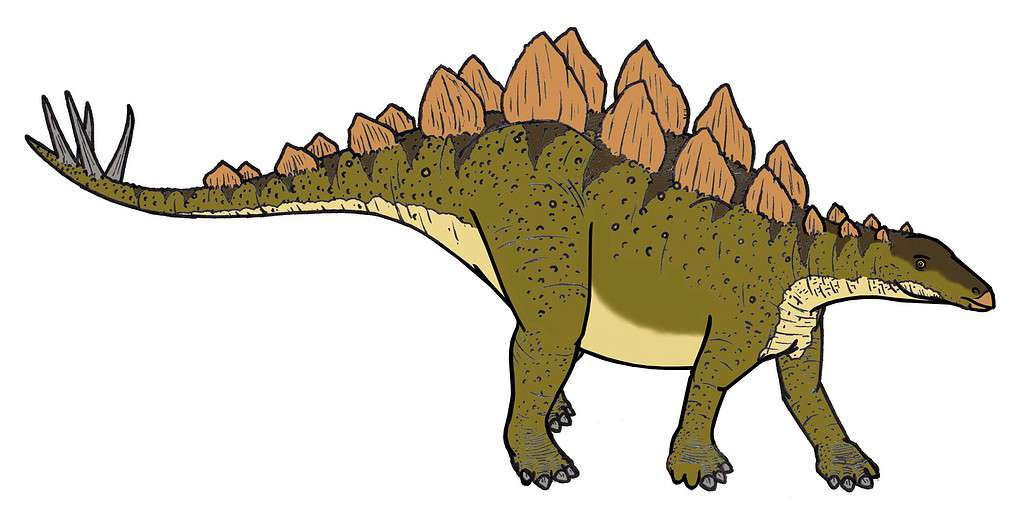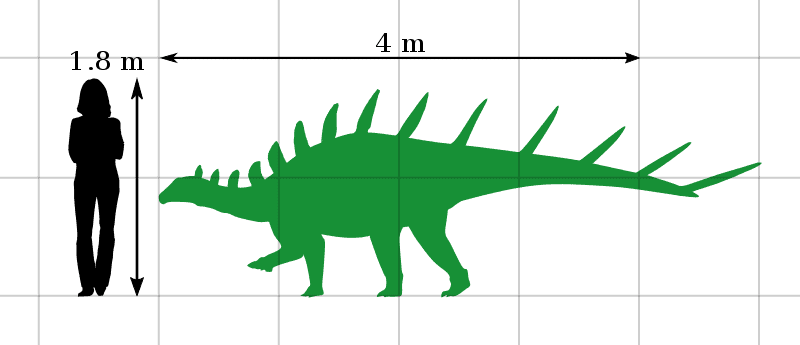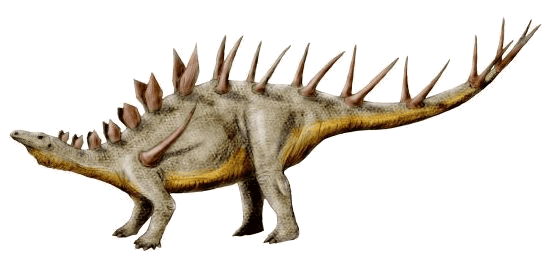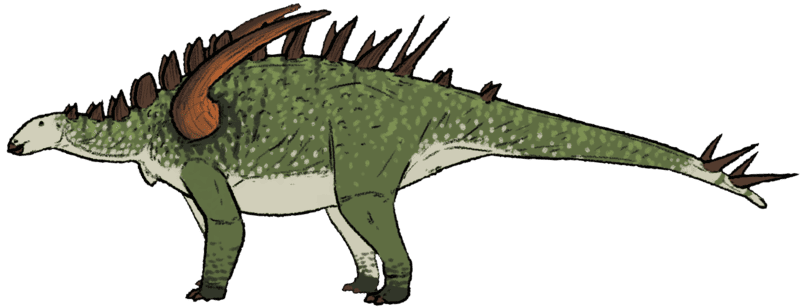The Stegosaurus is one of the most iconic dinosaurs to ever roam the planet. You might remember it from your childhood, that imposing creature with double rows of large, flat plates running down its back and spikes on its tail. But the Stegosaurus was pretty chill. It roamed the land during the Jurassic Period, around 150 million years ago, grazing on vegetation (we don’t really know what type of vegetation it ate).
Although there’s much we still don’t yet know about it, researchers have learned quite a lot about the stegosaurus. So let’s take a deep dive and get acquainted with this fascinating dinosaur that once roamed our Earth.
Introducing the Stegosaurus

A Jurassic Giant
The Stegosaurus lived during the Late Jurassic Period (in the broader period called the Mesozoic), around 150 million years ago. It’s a common misconception that they lived at the same time as other popular dinosaurs like Triceratops and T-Rex. This is not true: T-Rex and Triceratops emerged later, during a period called the Cretaceous, some 90 to 68 million years ago.
In fact, the Stegosaur seemed to exist for a relatively short time of only 10 million years, from 155 and 145 million years ago. But in that period, they were very common and widespread.
This massive creature weighed as much as five tons and in some instances, measured up to seven meters (23 ft) — but it was a herbivorous dinosaur. Imagine a gentle giant, slowly lumbering across the land, nibbling on ferns and other prehistoric plants. However, their teeth and jaws are very different from those of other herbivores, so we don’t really know exactly what they ate. They would have had a very large range of plants to munch on.
In the Jurassic, the world was much different than it is today. Picture a world teeming with lush vegetation, strong monsoons, and a very hot atmosphere. If you’re living during that period (and especially if you’re a cold-blooded creature), you’d need some way to cool down — and that could be why it had its distinctive plates.
A Distinctive Design

The Stegosaurus’s most striking feature is its double row of large, flat plates along its back and the spikes on its tail. Think of a knight in shining armor, but instead of metal, it has bony structures. But we don’t really know what the plates did. They may have not been used for defense at all, but rather for thermal regulation or even sexual display. We’ll look at this in more detail in a moment.
The dinosaur had a small head in comparison to its body, and its brain was famously the size of a dog’s brain. Stegosaurus was a social creature. It couldn’t move fast, and likely spent much of its time in a herd-type structure. Dinosaur tracks suggest that Stegosaurs of various ages lived together.
The Thagomizer
Another distinctive feature is the arrangement of spikes. Essentially, all Stegosaurs feature some form of spikes on their tails, measuring 60–90 cm (2–3 ft) long. Discoveries of articulated stegosaur armor show that, at least in some species, these spikes protruded horizontally from the tail, not vertically as is often depicted.
Paleontologists initially thought the spikes were a weapon. Then, some researchers started suggesting that maybe they were used more for display. Now, the scientific community has come full circle: more and more evidence suggests they were indeed a weapon.
Fossil records show injuries in predators that match the size and shape of the Stegosaurus spikes, telling an epic story of prehistoric battles and survival. In addition, the tail of the Stegosaurus was more flexible, which fits with the idea of using it as a weapon, and many Stegosaurs also had damage in their tails.
These spikes are referred to as “the thagomizer.” This naming didn’t come from scientists, but rather from a funny comic. The 1982 The Far Side comic shows a group of cavemen taught by a caveman lecturer. The lecturer mentions that the spikes on a stegosaur’s tail are named “after the late Thag Simmons” (a made-up name). Many researchers and paleontological institutions use this name now.

Finding and naming Stegosaurus
The first Stegosaurus skeleton was discovered in 1877 in Colorado, USA. Since then, paleontologists have found numerous other specimens, each one adding to our understanding of this extraordinary creature.
The dinosaur was discovered during the so-called “Bone Wars.” The “Bone Wars” were a time of ruthless fossil hunting during the Gilded Age of American history. Initially, the Stegosaurus was thought to be a turtle-like creature — now we know better.
The name “Stegosaurus” comes from the Greek words “stegos,” meaning “roof” or “cover,” and “sauros,” meaning “lizard.” Together, these terms form “roofed lizard” or “covered lizard.”
The dinosaur name stuck even as our understanding of it improved.
Why Did Stegosaurus Have Plates on Its Back?
This brings us to the most hotly debated aspect of Stegosaur biology: its back plates.
The Stegosaurus’s distinctive plates are more than just eye-catching features: they’re a riddle wrapped in a prehistoric enigma. What purpose did these plates serve? Researchers have long debated this and the matter is still not set. Here are the main theories about what the Stegosaurus plates were used for.
A Form of Defense: Intimidation and Protection
The first thing that would come to mind is defense. Paleontologists have suggested that the plates were used for defense, although some scientists have pointed out that they are ill-placed for something like this and not tough enough.
The plates were made from keratin, the same substance your fingernails are made of — not bone. But recent studies have suggested the plates would have been sharp, which also hints at some defensive function.
Consider the sight of those large plates from a predator’s point of view. They could have served as a deterrent, making the Stegosaurus appear even larger and more formidable. Much like a porcupine’s quills stand up when threatened, the plates would have intimidated would-be attackers.
At any rate, this basic idea that the plates were used for defense may yet have some merit to it.
Thermal Regulation
Some researchers have proposed that these plates served as a kind of thermal regulation system. Dinosaurs like the Stegosaur had few ways to cool down. The plates had a lot of blood vessels running through grooves and they may have acted as thermoregulatory devices. In other words, the dinosaur used the plates to cool down.
Imagine standing beside a Stegosaurus on a hot day, and the plates on its back act like a car’s radiator, controlling its body temperature. The large surface area could have allowed blood to flow through, dissipating heat when it was too hot and absorbing warmth when it was cold. It’s like a natural temperature control system.
This theory has also been challenged because some Stegosaurs had plates with lower surfaces. This suggests they wouldn’t have been very good at cooling. Nevertheless, this idea is still one of the main hypotheses for the use of Stegosaur plates.
A Show of Color and Beauty: Mating Displays
However, there are other theories as well. Stegosaur plates differed between sexes, suggesting they could have had a sexual role. The plates could have played a role in advertising sexual fitness. Like the bright plumage of a peacock, they would allow the Stegosaurus to communicate or attract mates.
Think of them as nature’s flashy advertisements, attracting attention in the dense prehistoric jungles.
Conclusion: A Mystery Yet to Be Fully Uncovered
While these theories offer tantalizing insights, the true purpose of the Stegosaurus’s plates remains a subject of ongoing research and debate. It’s a puzzle that continues to challenge and inspire paleontologists.
Deciphering the biological code written millions of years ago is not easy. With every study, we get closer to understanding the function of these plates — but we’re not just there yet.
Stegosaur facts
Whether it’s the iconic plates, the intriguing theories, or the wide geographical spread, these dinosaurs continue to be a source of fascination and exploration. Here are some of our favorite facts about them:
- Distinctive Features: Stegosaurs are known for their distinctive double row of large, flat plates along their back and the spikes on their tail.
- Herbivorous Dinosaurs: They were primarily herbivores, probably feasting on ferns, cycads, and other prehistoric plants.
- Jurassic Era Giants: Most Stegosaur species lived during the Late Jurassic period, around 150 million years ago.
- Brain Size: Despite their large size, Stegosaurs had a remarkably small brain, often compared to the size of a walnut.
- Global Presence: Fossils of Stegosaurs have been found across different continents, including North America, Europe, Africa, and Asia.
- Tail Weaponry: The Stegosaurus’s tail spikes, known as the thagomizer, could be used as a powerful weapon against predators.
- Mysterious Plates: The purpose of the Stegosaurus’s plates remains a subject of debate and study; they may have been used for temperature regulation, mating displays, or defense.
- Diverse Family: The Stegosauridae family includes various species with unique characteristics, such as the long-spiked Kentrosaurus and the large-shouldered Gigantspinosaurus.
- Iconic Dinosaur: The Stegosaurus is one of the most recognizable dinosaurs and has become a symbol of prehistoric life.
- Cultural Impact: From museums to movies, the Stegosaurus has captured the imagination of people of all ages and continues to be a prominent figure in popular culture.

Dinosaurs Like Stegosaurus
The Stegosaurus doesn’t stand alone in its uniqueness. As you delve deeper into the world of Jurassic dinosaurs, you find other species with comparable features.
The Stegosaurus belongs to a larger group called the Stegosauridae, sharing some features with its relatives but possessing its own distinct characteristics.
Cousins with Spikes and Plates
Consider the Kentrosaurus, a cousin of Stegosaurus, with both spikes and plates. While the plates are smaller, the spikes are more prominent and deadly. Visualize a porcupine, but the size of a car, ready to defend itself with an arsenal of sharp quills.

Or picture the Hesperosaurus, another relative, with its back adorned with plates and spikes. It showcases the diversity of this extraordinary family, each member with a unique approach to survival.
| Species | Period | Location | Max size | Notable Characteristics |
|---|---|---|---|---|
| Stegosaurus ungulatus | Late Jurassic | Western North America | 30 feet (9.1 meters) | Large, flat plates; spiked tail (thagomizer) |
| Kentrosaurus | Late Jurassic | Africa (Tanzania) | 15 feet (4.6 meters) | Smaller plates; longer, more prominent spikes |
| Hesperosaurus | Late Jurassic | Western North America | 25 feet (7.6 meters) | Mixture of plates and spikes on back and tail |
| Gigantspinosaurus | Late Jurassic | China | 14 feet (4.3 meters) | Large shoulder spikes; smaller plates |
| Dacentrurus | Late Jurassic | Europe (England, France) | 20-25 feet (6.1-7.6 meters) | Long, flexible tail; small, rounded plates |
| Tuojiangosaurus | Late Jurassic | China | 23 feet (7 meters) | Double row of pointed plates; long spikes |

Frequently Asked Questions (FAQ) About Stegosaurus
A: The Stegosaurus primarily lived in what is now western North America, with most fossils found in the Morrison Formation in the United States. However, its relatives were widespread across the planet.
A: As a herbivore, the Stegosaurus ate a diet of plants. We still don’t know for sure, but this diet probably included ferns, cycads, and other prehistoric vegetation. Think of a giant, slow-moving lawnmower munching its way through ancient landscapes.
A: Surprisingly small! The brain of a Stegosaurus was about the size of a walnut, weighing only around 3 ounces. It’s a reminder that size isn’t everything, especially in the world of dinosaurs.
A: Those intimidating spikes on its tail were not just for show. The Stegosaurus could use its tail to swing at predators, delivering a powerful and potentially deadly blow.
A: The name “Stegosaurus” comes from Greek words meaning “roofed lizard” or “covered lizard.” It’s a reference to those distinctive plates along its back, resembling a roof of sorts.
A: Yes, the Stegosaurus is part of the Stegosauridae family, which includes other plated and spiked dinosaurs like Kentrosaurus and Hesperosaurus.
A: The truth is, scientists don’t know the exact color of the plates. The idea that they might have been colorful is a theory based on their potential use in display or mating. It’s one of the many mysteries still to be uncovered.
No, Stegosaurus, Tyrannosaurus Rex (T-Rex), and Triceratops did not all live at the same time. Stegosaurs lived during the Late Jurassic period, approximately 155 to 150 million years ago. Meanwhile, Triceratops and T-Rex lived 68 to 66 million years ago.
A Timeless Fascination
The Stegosaurus continues to captivate us and is without a doubt one of the most iconic creatures out there. It’s not just because of its intriguing appearance but because it opens a window into a time long past. You can’t help but wonder what it must have been like to walk among these magnificent creatures.
From its name to the mysteries regarding its biology, the journey of understanding the Stegosaurus is a trip into the mystery of evolution and the creativity of nature. It’s a glimpse into a world both alien and familiar, a reminder of the complexity of life on Earth.





